
Reach your personal and professional goals
Unlock access to hundreds of expert online courses and degrees from top universities and educators to gain accredited qualifications and professional CV-building certificates.
Join over 18 million learners to launch, switch or build upon your career, all at your own pace, across a wide range of topic areas.


 Structure of an atom (source: Janet Montgomery)
Structure of an atom (source: Janet Montgomery)
 Example of oxygen isotopes. Note the different number of neutrons in the nuclei. (Source: Wiki Commons)
Example of oxygen isotopes. Note the different number of neutrons in the nuclei. (Source: Wiki Commons) Examples of tissue types used in archaeological isotope studies. (Source: Wiki Commons)
Examples of tissue types used in archaeological isotope studies. (Source: Wiki Commons)






